This is notes from video lecture of
https://www.youtube.com/watch?v=ogZi5oIo4fI&list=PLlMkM4tgfjnJ3I-dbhO9JTw7gNty6o_2m&index=13&t=0s
================================================================================
 Deep Neural Network (DNN)
================================================================================
Deep Neural Network (DNN)
================================================================================
 CNN is slightly different from DNN.
Instead of using all data in image,
CNN focuses on some certain areas, with extracting feature of image.
You will have many feature-image if you use many number of CNN image filters.
================================================================================
CNN is slightly different from DNN.
Instead of using all data in image,
CNN focuses on some certain areas, with extracting feature of image.
You will have many feature-image if you use many number of CNN image filters.
================================================================================
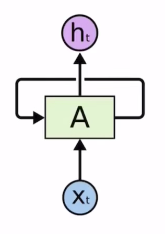 $$$X_t$$$: input data
$$$h_t$$$: output data
Center acrossing arrow: hidden state which is passed into next cell
================================================================================
$$$X_t$$$: input data
$$$h_t$$$: output data
Center acrossing arrow: hidden state which is passed into next cell
================================================================================
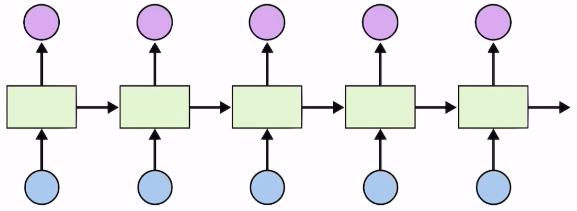 Unfolded view
Each one (green squres) has series of inputs (blue circles) like $$$x_1,x_2,...$$$
Each one (green squres) produces series of outputs (red circles) like $$$y_1,y_2,...$$$
Interesting thing in RNN is $$$y_1$$$ is passed into next cell (next green squre) as privious state
With $$$y_1$$$ and $$$x_2$$$, 2nd cell creates $$$y_2$$$
================================================================================
RNN can be used for series data, for example,
- Time series prediction
- Language modeling (text generation)
- Text sentiment analysis
- Named Entity Recognition (NER)
- Translation
- Speech recognition
- Music composition
================================================================================
Various RNN models
Unfolded view
Each one (green squres) has series of inputs (blue circles) like $$$x_1,x_2,...$$$
Each one (green squres) produces series of outputs (red circles) like $$$y_1,y_2,...$$$
Interesting thing in RNN is $$$y_1$$$ is passed into next cell (next green squre) as privious state
With $$$y_1$$$ and $$$x_2$$$, 2nd cell creates $$$y_2$$$
================================================================================
RNN can be used for series data, for example,
- Time series prediction
- Language modeling (text generation)
- Text sentiment analysis
- Named Entity Recognition (NER)
- Translation
- Speech recognition
- Music composition
================================================================================
Various RNN models
 - One to Many: Image captioning
One input image
Multiple captions on that image
- Many to One:
Sentence input which composed of multiple tokens
Output is one sentiment
- Many to Many: Translation
================================================================================
See the inside of RNN
- One to Many: Image captioning
One input image
Multiple captions on that image
- Many to One:
Sentence input which composed of multiple tokens
Output is one sentiment
- Many to Many: Translation
================================================================================
See the inside of RNN
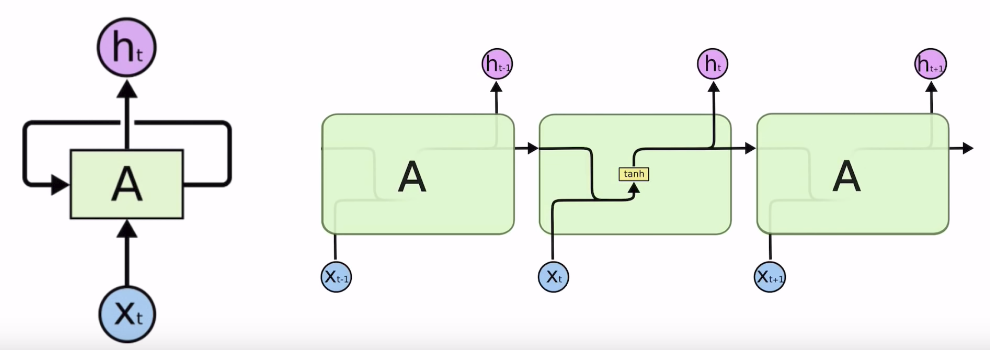 Code:
Code:
mixed=Mat_mul(hidden_state_from_privious_cell,current_input)
after_tanh=tanh(mixed)
output,previous_state_for_next_cell=after_tanh
# c input_size: size of input data
# c hidden_size: size of output and previous-state-for-next-cell
# c batch_first: batch data first for your input data like (batch_size,sequence_length,input_size)
cell=nn.RNN(input_size=4,hidden_size=2,batch_first=True)
cell=nn.GRU(input_size=4,hidden_size=2,batch_first=True)
cell=nn.LSTM(input_size=4,hidden_size=2,batch_first=True)
 Code:
Code:
cell=nn.RNN(input_size=4,hidden_size=2,batch_first=True)
inputs=prepare input data in here
hidden=initial hidden state data
# c out: h_t
# c hidden: previous state for next cell
out,hidden=cell(inputs,hidden)
# Implement next cell
# c inputs: input for this cell
# c hidden: is from previous cell
out,hidden=cell(inputs,hidden)
# c cell: one RNN cell
cell=nn.RNN(input_size=4,hidden_size=2,batch_first=True)
# ================================================================================
# c inputs: one letter as input, shape will be (1,1,4)
# Note that input_size=4 is same to 4 from (1,1,4)
inputs=autograd.Variable(torch.Tensor([[h]]))
# ================================================================================
# @ You initialize hidden state manually at initial time
# c hidden: hidden_size=2 should be same 2 from (1,1,2)
hidden=autograd.Variable(torch.randn(1,1,2))
# ================================================================================
# @ Feed one element to one cell
out,hidden=cell(inputs,hidden)
print(out)
# -0.1243 0.0738
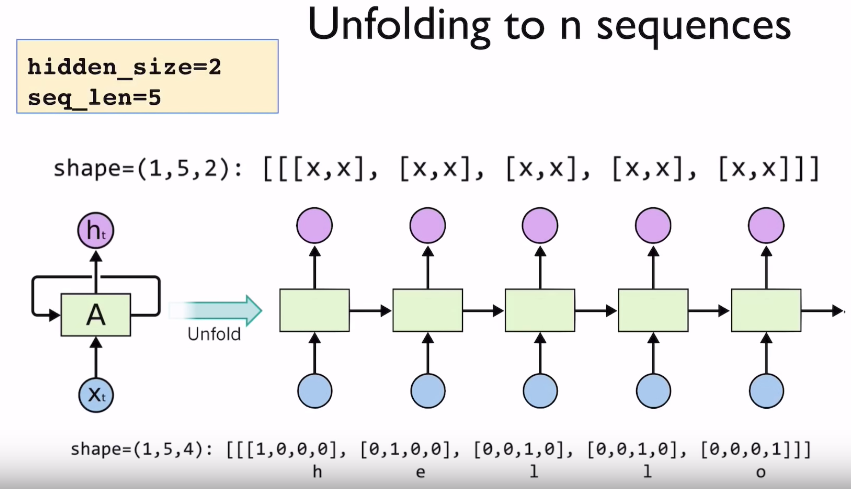 - seg_len=5 means 5 cells you use in RNN.
- Shape of output becomes (1,5,2)
1: batch size
5: number of cells as seq_len
2: output size
- Shape of input becomes (1,5,4)
================================================================================
Code:
- seg_len=5 means 5 cells you use in RNN.
- Shape of output becomes (1,5,2)
1: batch size
5: number of cells as seq_len
2: output size
- Shape of input becomes (1,5,4)
================================================================================
Code:
cell=nn.RNN(input_size=4,hidden_size=2,batch_first=True)
# ================================================================================
inputs=autograd.Variable(torch.Tensor([[h,e,l,l,o]]))
print(inputs.size())
# ================================================================================
hidden=autograd.Variable(torch.randn(1,1,2))
# ================================================================================
out,hidden=cell(inputs,hidden)
print(out.data)
 ================================================================================
Code:
================================================================================
Code:
cell=nn.RNN(input_size=4,hidden_size=2,batch_first=True)
# ================================================================================
batch_input=[
[h,e,l,l,o],
[e,o,l,l,l],
[l,l,e,e,l]]
inputs=autograd.Variable(torch.Tensor())
print(inputs.size())
# (3,5,4)
# ================================================================================
hidden=autograd.Variable(torch.randn(1,1,2))
# ================================================================================
out,hidden=cell(inputs,hidden)
print(out.data)
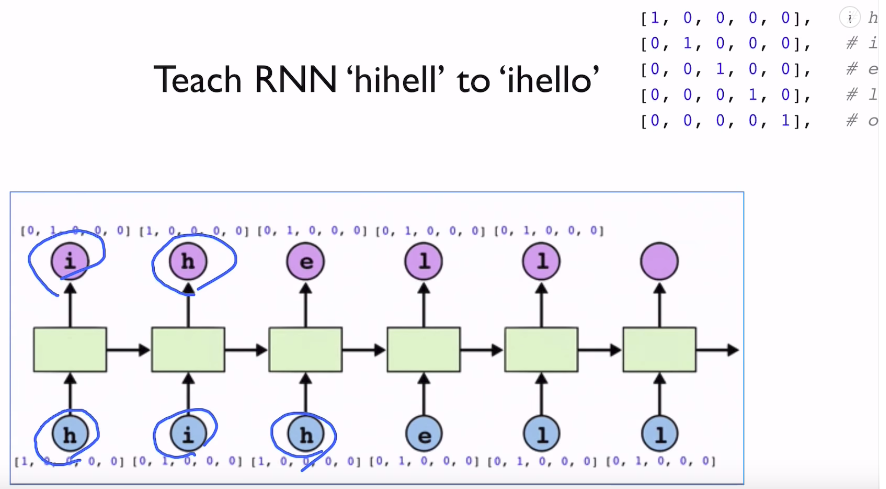 Teach RNN model to learn context of "ihello" from "hihell"
================================================================================
Teach RNN model to learn context of "ihello" from "hihell"
================================================================================
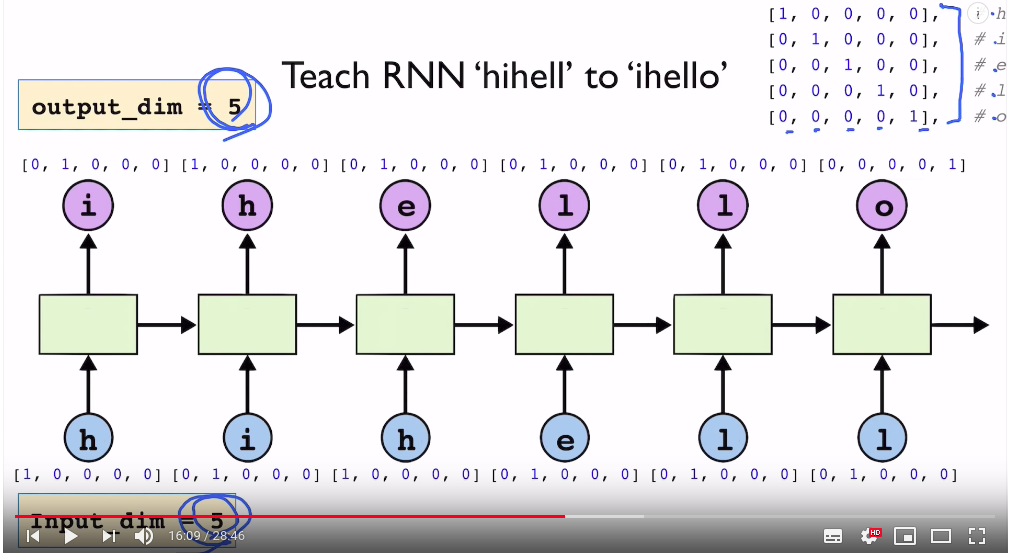 ================================================================================
================================================================================
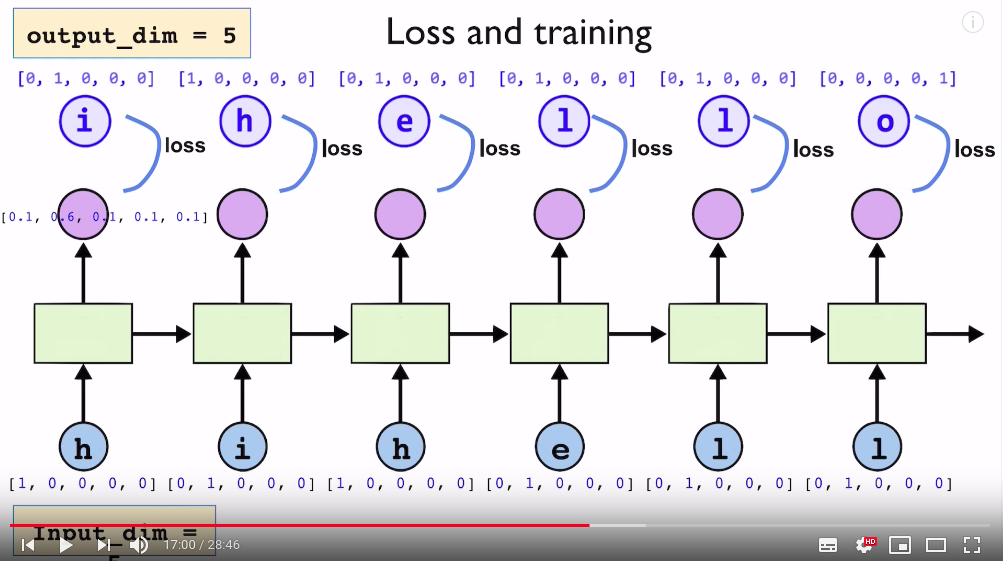 i,h,e,l,l,o are target $$$y$$$
Red cells are predictions $$$\hat{y}$$$
You use loss functions like cross entropy
Then, you can sum all those losses or you can average those losses
to create one scalar loss value
================================================================================
Example
Code:
i,h,e,l,l,o are target $$$y$$$
Red cells are predictions $$$\hat{y}$$$
You use loss functions like cross entropy
Then, you can sum all those losses or you can average those losses
to create one scalar loss value
================================================================================
Example
Code:
idx2char=['h','i','e','l','o']
# ================================================================================
# @ Teach RNN to know the conext of "hihell->ihello"
# c x_data: represents hihell
# c x_data: indices of each character from character dictionary idx2char
x_data=[0,1,0,2,3,3]
one_hot_lookup=[
[1,0,0,0,0],
[0,1,0,0,0]
[0,0,1,0,0]
[0,0,0,1,0]
[0,0,0,0,1]]
# c y_data: represents ihello
y_data=[1,0,2,3,3,4]
# c x_one_hot: convert x_data into one hot representation
x_one_hot=[one_hot_lookup[x] for x in x_data]
# ================================================================================
inputs=Variable(torch.Tensor(x_one_hot))
labels=Variable(torch.Tensor(y_data))
# ================================================================================
# @ Parameters
num_classes=5
input_size=5 # dimension of one hot representatio which encodes one character
hidden_size=5
batch_size=5
sequence_length=1 # perform tasks one by one, not using series of cells
num_layers=5 # one-layer RNN
# ================================================================================
# @ Model
class Model(nn.Module):
def __init__(self):
super(Model,self).__init__()
self.rnn=nn.RNN(input_size=input_size, hidden_size=hidden_size,batch_first=True)
def forward(self,x,hidden):
# Reshape input to (batch_size,sequence_length,input_size)
x=x.view(batch_size,sequence_length,input_size)
# --------------------------------------------------------------------------------
# Propagate input through RNN
out,hidden=self.rnn(x,hidden)
out=out.view(-1,num_classes)
return hidden,out
def init_hidden(self):
# Initialize hidden and cell states
# (num_layers*num_directions,batch,hidden_size)
return Variable(torch.zeros(num_layers,batch_size,hidden_size))











